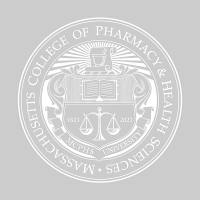MCPHS Student Arms Classmates with a New Perspective on Physics
By Maaha RafiqueOhuninioluwa presenting her work on the model arm at the MCPHS Student Research Conference.
Through a hands-on demonstration, Olujimi Ohuninioluwa helped students see the link between physics and medicine.
Physics is a required course for many healthcare students, but its relevance isn’t always immediately clear. Olujimi Ohuninioluwa, BS ‘25, set out to change that. Working with physics professor Dr. Janet Cutro at Massachusetts College of Pharmacy and Health Sciences (MCPHS), she developed a demonstration using a model of a human arm to show how physics applies directly to the human body. Her goal: to help fellow students see physics as a fundamental part of healthcare, rather than just another prerequisite course.
“At a health sciences school, unless there is something that directly connects it to what we feel like our field of study is, it doesn't feel as important. But that was my way of showing that physics is 100 percent a class you need to take to be a healthcare worker for so many reasons,” Ohuninioluwa said.
Ohuninioluwa’s idea took shape at the end of the spring semester, when she and Dr. Cutro began discussing ways to highlight the real-world applications of physics. Over the summer, they met several times to refine their approach. They focused on a physics lab model of a human arm, which had a cord that activated movement when pulled. The model also came with sensors capable of measuring force in Newtons when attached to different muscles.
To ensure accuracy, Ohuninioluwa reached out to the company that manufactured the model, working with them to determine the best way to connect the sensors for her demonstration.
“As the study of natural phenomena, including the forces that govern the motion of matter through space and time, physics plays a crucial role in understanding the mechanics of the human body,” said Dr. Cutro. “Ini’s work on human arm motion clearly showed the relevance of physics in the health care professions and the importance of research experience in career development.”
When the fall semester began, Ohuninioluwa returned to the physics classroom—not as a student, but as a guest presenter. She invited students to feel their own arm muscles as they moved, then demonstrated the same principles using the model. With the sensors connected to a computer display, students could observe in real time how force was exerted by and on the biceps.
“The actual muscles on the model do not move. So, we attached strings to them to show the movement, and have a visual of what was going on. A lot of people, like myself, learn well with visual and physical representations like that,” she said.
Ohuninioluwa said the presentation was well-received by the students. She and Dr. Cutro are working to publish the demonstration as a case study, with the goal of inspiring others to explore the connections between physics and healthcare.
“I’ve loved math since I was a kid, and the math-based classes at MCPHS have been my best academic experiences,” Ohuninioluwa said. “My work with Dr. Cutro and other research I’ve done have made me feel sure that this is what I want to do for the rest of my life.”
Featured Connections
People

More University News
Meeting the Moment: Student Research Conference Explores AI in Healthcare
The annual event highlighted how artificial intelligence can transform healthcare and showcased student research projects from disciplines across the University.
AI in Healthcare: MCPHS Leads the Conversation on Innovation
A new speaker series explores practical applications of artificial intelligence to shape the future of healthcare and healthcare education.
Scholarship on Display: Showcase Features Student Research
Thirty teams of students from the Worcester and Manchester campuses presented their work at the annual event.
A Celebration of Collaboration: April is National Interprofessional Healthcare Month
Training future practitioners to work together to provide safer, higher quality healthcare.

